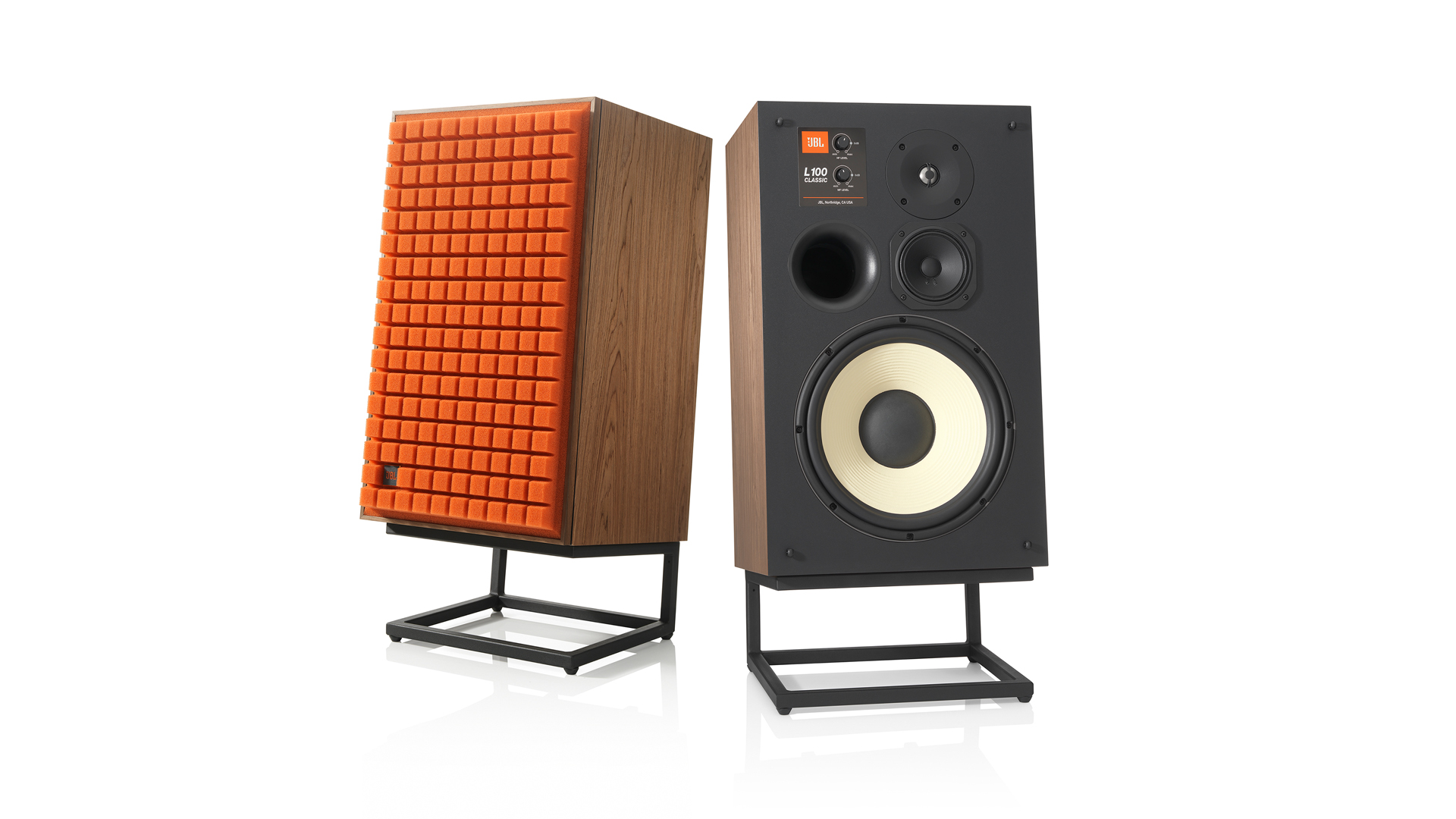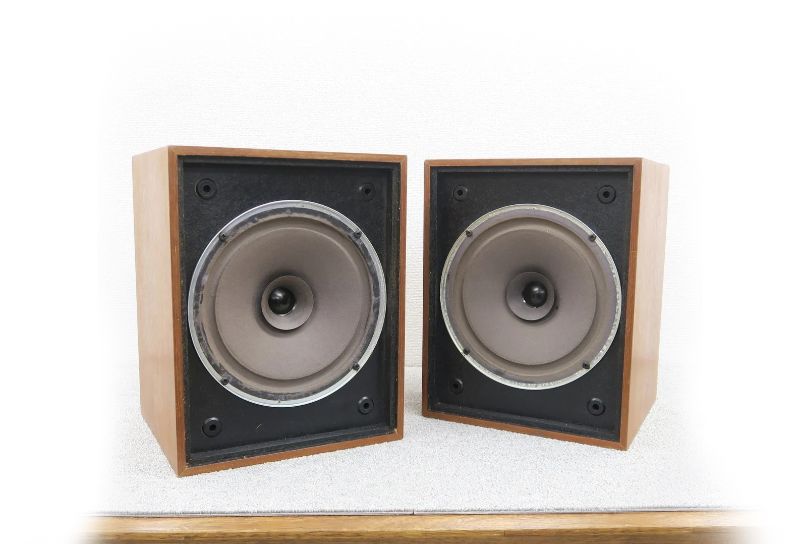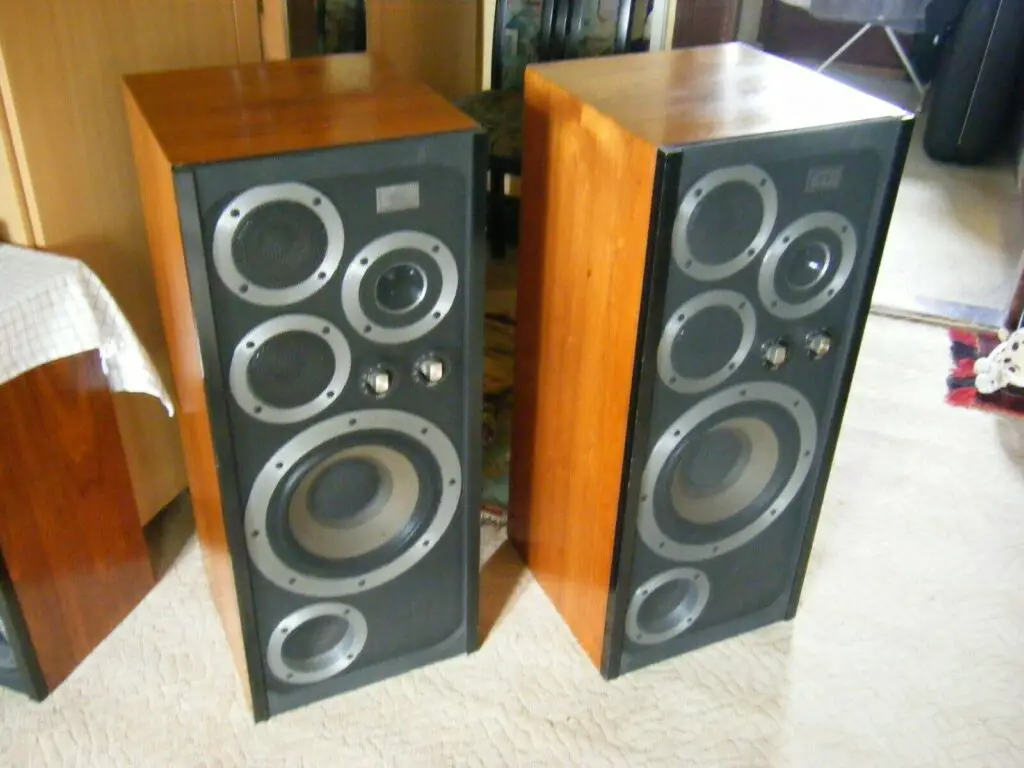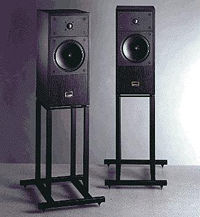Few could have predicted how popular the JBL L100 would become when it was initially introduced at CES 1970 in Chicago. It was a consumer version of the professional 4310/4311 monitors, with the same driver lineup and powerful Alnico V magnets. For the midrange and treble drivers, a basic crossover was used, with the bass unit bypassing it entirely. It had that distinctive ‘West Coast sound,’ which was dry, detailed, and punchy, just like the BBC LS3/5a.
It was rumored to have been styled by JBL president Arnold Wolf and appeared to be stunningly futuristic at the time. There were several variations, including the L100A and L100 Century evolutions, the latter of which lasted until 1978 when the speaker was retired. This was a tremendous hit in Japan, and the 4312E version remained on the market for a long time, gaining cult status. Various mid and treble drivers, as well as different front baffle positions, have been attempted over the years. The L-series survived into the 1980s, but it had nothing in common with the original. And then there’s this: the reinvented JBL L100 Classic, which comes the closest to the original in decades.
With the 4312SE 70th Anniversary Studio Monitor, which was released three years ago, and this new £3,999 design, JBL is riding the retro-futuristic zeitgeist. On a Ford Capri, it’s remarkable for offering the hi-fi equivalent of a racing stripe: an orange-colored, molded foam Quadrex grille. Even without the grille, this loudspeaker has the same vintage vibe as a pair of crushed velvet flares. Consider the front baffle’s extremely broad opening, the angled floorstand’s small and stubby length, and the midrange and treble level pads!
The cabinetry is elegant, with a true satin walnut wood veneer finish, but the loudspeaker’s appearance is dominated by the broad front baffle. The three drive units steal the show, particularly the 300mm 1200FE cast-frame woofer with its white pulp cone. This is coupled with a 125mm JM125PC midrange driver, which features a pulp cone and a cast-frame chassis. Finally, the L100 Classic employs JBL’s newly developed 25mm JT025Ti1 titanium dome tweeter, which is coupled to an acoustic lens-equipped waveguide. Don’t be fooled by their appearances; these drivers are all brand new designs, even if they appear to be from another era. Since the 1970s, midrange and treble level adjustments have been nearly universally installed on high-end speakers, but fashion has shifted in the opposite direction, and they are now uncommon. They’re back on the L100 Classic, and they’re actually quite useful for fine-tuning the speaker to one’s listening area and/or system. A huge front baffle-mounted bass reflex port with a gracefully flared exit is also included.
A single pair of gold-plated binding posts can be found around the rear. The wood veneer is of high quality, but nowhere like as elegant as what you’d find on a Monitor Audio for less than half the price. While the overall build quality is better than the original, it is still nothing to write home about for the price. The speaker grille is fastened to the front baffle by mounting pegs, which are both fragile and unattractive, as was usual practice in the 1970s. For the L100 Classic, JBL offers an optional stand that raises the speaker just enough off the ground to be useful while also slightly angling it upwards. It can be used vertically or horizontally, according to the manufacturer, and I chose the former.
The speaker was relatively straightforward to set with this attached, functioning nicely about 60cm from a boundary wall and firing down the room. It didn’t seem to excite the room as much as most of the other speakers I’ve tested. Because everything sounded a little too lively in the default setting, the final listening was done with the level pads at twelve o’clock.
JBL’s new L100 is as unobtrusive acoustically as it is visually – that is, none at all. This megaphone has its own wonderful way of getting things done. It’s a design that’s not so much about character as it is about charisma. It has a bright, lively tone that really ‘wakes up’ whatever track you’re playing. It also has a delightfully energetic rhythmic quality that makes you want to tap your feet nonstop. It’s dynamic in its own right, but it’s far better at picking up minor accents than the huge, earth-shattering crescendos of a full orchestra. It sounds spacious, but image placement inside the soundstage is poor for the price, and there is no convincing stage depth.
Tonally, the L100 is a fun trip back to the 1970s; this is the kind of sound that many rock music fans aspired to back then. This loudspeaker is inherently upfront; its midband isn’t shy, and the treble is constantly bright. For example, the trumpets on Herbie Hancock’s ‘Riot’ seem gleaming, leaping out at the listener with a visceral quality that makes most modern designs sound tame. There’s also a lot of surface detail, like a bright piano sound that resounds with vim and purpose throughout the mix. Even the flute work, which is generally used to provide a smooth, lush feel to jazz songs, came across as rough and scratchy. Owners of the original L100 would undoubtedly refer to this as “the traditional JBL sound,” despite many of the company’s more contemporary versions are a long way from it. It has a distinct sound that is as appealing to the ear as the orange grille is to the sight.
The speaker is a tad mid-forward in absolute terms, which means its hefty bass unit is less of a player on the field than you might think given its size. The delicate double bass performance on the Herbie Hancock track, for example, lacked the weight and extension that you’d expect. It’s less prone to ‘one note’ than previous versions of this speaker I’ve heard, but it’s still not the best at depicting how basslines progress up and down the scale. This was notably obvious with electronic pop, such as New Order’s ‘Vanishing Point’, which lost some of its force due to the weak bottom end. Dropping the mid and treble knobs had little influence in this case. The track’s drum machine hi-hat cymbal patterns seemed a little too crisp for my tastes at the opposite end of the frequency spectrum, and the tweeter isn’t the sweetest thing JBL has ever developed, to be honest.
When the speaker is asked to play fast, repetitive beat-driven music, such as YMO’s ‘Music Plans,’ any reservations about the speaker’s lack of neutrality are quickly ignored. Over a harsh metronomic beat, thick, crunchy analogue synthesizers tussle with one another in this early eighties electro track. The music has a dark and bleak tone to it, but the L100’s transient speed added a lot of life to it. Its light, nimble nature allowed me to enjoy the interplay between the booming bass drum and the snare/rim shot sounds. This speaker does indeed carry percussion brilliantly, with a swagger that makes listening enjoyable.
Its management of microdynamics is a major aspect of its expressive nature. The indie rock strains of Microdisney’s ‘Loftholdingswood’ demonstrated the L100’s fondness for this sort of music. It appreciates a large-scale rock production that it can sink its teeth into. Despite its flaws, the way it goes about generating music has a nice lucid clarity about it that’s impossible not to admire. The track’s crashing piano power chords and cranked-up, jangling Rickenbacker lead guitar, as well as Cathal Coughan’s gutsy vocals, were a treat. It’s sly, though, because there’s a sense that some of the song’s low-level intricacy is being obfuscated if you listen attentively. On the surface, it’s cheerful and bright, yet you’re left wanting more insight and transparency.
Its lack of ‘handed’ front baffles may put it at a disadvantage in terms of sound staging. I found it lacking in this regard when firing straight down the room, though introducing a few degrees of toe-in greatly helped. However, no amount of location experimentation could compensate for the reality that the L100 is ‘sub-optimal’ in comparison to most recent designs. ‘London Can Take It,’ by Public Service Broadcasting, is current progressive pop that sounds delightfully panoramic through the appropriate setup. But not here; even if the L100 Classic did open up a little, it lacked the resolution to go deep enough into the tape to accurately express spatial information. Despite a rather wide left-to-right spread, stereo image was rudimentary, with minimal stage depth. This new loudspeaker is entertaining, but it has flaws – what it lacks in precision, it makes up for in personality, assuming that’s the sound the potential buyer desires.
The new L100 Classic from JBL isn’t perfect in some areas, so it won’t be for everyone, but it sounds better than the sum of its parts in numerous ways. It’s more fun than it should be, for example, and it serves as a reminder of how dull and formulaic so many modern designs are. This skillfully reinvented blast from the past will win friends but alienate others, making it one of the most ‘Marmite’ hi-fi goods now on the market.







